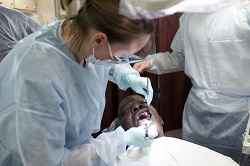Dental Laboratory Procedures
- Home
- Medical Categories
- Dental Procedures/surgeries
- Dental Laboratory Procedures
Dental Laboratory Procedures
 Dental laboratory technicians at our institutions, fill prescriptions from dentists for crowns, bridges, dentures, and other dental prosthetics. First, dentists send a specification of the item to be manufactured, along with an impression (mold) of the patient's mouth or teeth. Then, dental laboratory technicians, also called dental technicians, create a model of the patient's mouth by pouring plaster into the impression and allowing it to set. Next, they place the model on an apparatus that mimics the bite and movement of the patient's jaw. The model serves as the basis of the prosthetic device. Technicians examine the model, noting the size and shape of the adjacent teeth, as well as gaps within the gum line. Based upon these observations and the dentists specifications, technicians build and shape a wax tooth or teeth model, using small hand instruments called wax spatulas and wax carvers. They use this wax model to cast the metal framework for the prosthetic device.
Dental laboratory technicians at our institutions, fill prescriptions from dentists for crowns, bridges, dentures, and other dental prosthetics. First, dentists send a specification of the item to be manufactured, along with an impression (mold) of the patient's mouth or teeth. Then, dental laboratory technicians, also called dental technicians, create a model of the patient's mouth by pouring plaster into the impression and allowing it to set. Next, they place the model on an apparatus that mimics the bite and movement of the patient's jaw. The model serves as the basis of the prosthetic device. Technicians examine the model, noting the size and shape of the adjacent teeth, as well as gaps within the gum line. Based upon these observations and the dentists specifications, technicians build and shape a wax tooth or teeth model, using small hand instruments called wax spatulas and wax carvers. They use this wax model to cast the metal framework for the prosthetic device.
After the wax tooth has been formed, dental technicians pour the cast and form the metal and, using small hand-held tools, prepare the surface to allow the metal and porcelain to bond. They then apply porcelain in layers, to arrive at the precise shape and color of a tooth. Technicians place the tooth in a porcelain furnace to bake the porcelain onto the metal framework, and then adjust the shape and color, with subsequent grinding and addition of porcelain to achieve a sealed finish. The final product is a nearly exact replica of the lost tooth or teeth.

 EN
EN
 AR
AR
 RU
RU
 DE
DE
 FR
FR
Required More info on Dental Laboratory Procedures? Leave a message